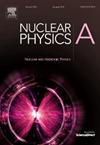用递推公式和Jacobi矩阵研究U(5)↔SO(6)过渡区中激发态量子相变
IF 1.7
4区 物理与天体物理
Q2 PHYSICS, NUCLEAR
引用次数: 0
摘要
本文对激发态量子相变(ESQPT)进行了理论研究。为此,基于正交多项式理论中的逆关系公式和雅可比矩阵,我们给出了U(5)和O(6)两相之间模型过渡的数值解。我们得到了给定N的激发态能谱,并且很好地观察到了跃迁区。能谱的一个显著特征是,对于给定的N,所有的激发态都得到了。能级之间没有能级交叉是谱的另一个特征,其原因可以用正交多项式来证明。此外,还研究了玻色子数的期望值和能隙的比值,得到了较好的结果。本文章由计算机程序翻译,如有差异,请以英文原文为准。
Investigation of excited-state quantum phase transitions in the U(5)↔SO(6) transitional region by the recurrence formula and Jacobi matrix
In this paper, we have theoretically studied the Excited State Quantum Phase Transition . For this purpose, based on the formulas of the inverse relation and the Jacobian matrix from the theory of orthogonal polynomials, we have presented a numerical solution for the model transition between the two phases and . We have obtained the energy spectrum of the excited states for the given N and we have observed the transition region well in it. One of the prominent features of the energy spectrum is that for a given N, all the excited states are acquired. The absence of level crossing between levels is another characteristic of the spectrum, the reason for which can be proven using orthogonal polynomials. In addition, the expected value of the number of bosons and the ratio of the energy gaps have been studied, yielding good results in relation to them.
求助全文
通过发布文献求助,成功后即可免费获取论文全文。
去求助
来源期刊

Nuclear Physics A
物理-物理:核物理
CiteScore
3.60
自引率
7.10%
发文量
113
审稿时长
61 days
期刊介绍:
Nuclear Physics A focuses on the domain of nuclear and hadronic physics and includes the following subsections: Nuclear Structure and Dynamics; Intermediate and High Energy Heavy Ion Physics; Hadronic Physics; Electromagnetic and Weak Interactions; Nuclear Astrophysics. The emphasis is on original research papers. A number of carefully selected and reviewed conference proceedings are published as an integral part of the journal.
 求助内容:
求助内容: 应助结果提醒方式:
应助结果提醒方式:


